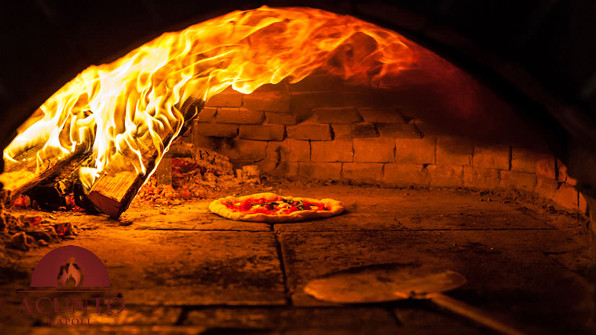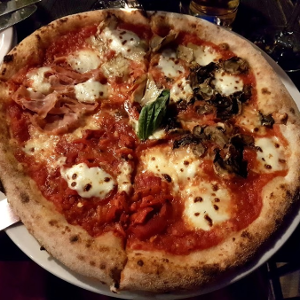Classic Neapolitan pizzaiolos will insist that baking the perfect pie is an art, not a science. But a Russian physicist living in Rome recently investigated the physics of pizza ovens and quantified the physics of the Pizza. Not without the help of two old-school Italian pizzaiolos, though…
 A classic wood-fired brick Pizza Oven: You can get at least part way there
A classic wood-fired brick Pizza Oven: You can get at least part way there
with your home oven oven and some crafty tips…
Without getting into the complex equations that describe heat flow and absorption, I’ll skip right to the major findings of a recent scientific paper by physicist Andrey Varlamov of Rome, Italy, materials scientist Andreas Glatz of the U.S. Argonne National Laboratory and food anthropologist Sergio Grasso, also of Rome.
Lead investigator Varlamov wanted to know why classic Italian Pizza baked in a wood-fired brick oven was so much better than Pizzas baked in other kinds of ovens. He especially wanted to discover why household ovens just couldn’t bake a Pizza anywhere near as good as the ones from the pizzeria.
It’s all about heat flow…
Varlamov and his team consulted two pizzaiolos at one of his favourite pizzerias in Rome and begged them to disclose the secrets of their method. Fortunately for him – and us – they agreed to talk.
It seems the ideal temperature for the wood fired brick pizza oven – measured in the middle of the chamber – is 330 F. Sounds low? Well, when you hear about pizza ovens that run at 600 F or even 900 F, they’re measuring the heat at the top of he chamber, not where the Pizza actually gets cooked. The temperature of the brick floor of the oven is only about 210 degrees. The differential is accounted for because the brick oven provides heat to the Pizza three ways: conduction (through the bricks), radiation (directly from the burning wood) and convection (created by the air rushing up the chimney and pulling in fresh air from the open mouth of the oven).
The very shape of the brick oven creates an environment that always cooks the crust perfectly while ensuring that the fillings (which need more heat) are also cooked properly.
Cooking time in the brick oven? Just two minutes!
What you can do at home…
Want to enhance your home-cooked Pizzas? Well, short of building a brick oven of your own, you’ll never be able to duplicate the Pizzas they make in classic pizzerias. But you can make some crafty changes in the way you arrange your oven racks and set your temperature.
I’ve found that placing your rack about two-thirds of the way down in the oven and topping it with a Pizza stone made of proper, traditional fire brick clay, is the best logistical arrangement. I also have another rack positioned high in the oven, near the ceiling of the chamber. I’ll get to why in a moment.
Careful with the heat!
It’s important to preheat your oven to the proper temperature first. Never put a Pizza in a cold oven, or even one that’s not fully up to temp. I have a true-convection oven, so I set the oven on convect and choose a temp of 350 F. That’s automatically reduced to 325 F by my range, to adjust for the faster cooking time under convection. And that’s just about perfect.
When the oven is all set, I slide the Pizza onto the stone and give it three minutes. Electric and gas ovens just don’t have the punch of a wood-fired brick oven, because they have only bottom and top heat, not the direct radiant heat of the classic oven. That means they’ll also take longer to bake your pizza.
After three minutes, I check the crust to see if it’s begun browning on the bottom and if the edges are rising nicely. It’s a good idea to rotate the pie at this point to ensure that it cooks evenly. The back of the oven is always hotter than the front.
You’ll also drop the temperature of the oven when you open the door, which is a bad idea. Open the door only when absolutely necessary, and don’t doddle!
When the crust is nicely browned on the bottom, slip your paddle under it and transfer the pie to the upper rack for just a minute or so. This will ensure that your toppings are fully cooked and the Cheese, especially, is string-pullin’ good!
Art vs. science…
Now you can see why baking the perfect Pizza is at least as much science as art. But, no matter how good you become at emulating the work of the classic pizzaiolo at home, you’ll never match their results – unless, of course, you have one of those trendy kitchen smoke generators that many celebrity chefs use to infuse their foods with ‘that outdoor tang’!
~ Maggie J.

